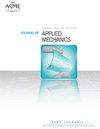Large Deflection Effects on the Energy Release Rate and Mode Partitioning of the Single Cantilever Beam Sandwich Debond Configuration
IF 2.8
4区 工程技术
Q2 MECHANICS
引用次数: 0
Abstract
This paper investigates the effects of large deflections on the energy release rate and mode partitioning of face/core debonds for the Single Cantilever Beam Sandwich Composite testing configuration, which is loaded with an applied shear force and/or a bending moment. Studies in this topic have been done by employing geometrically linear theories (either Euler-Bernoulli or Timoshenko beam theory). This assumes that the deflection at the tip of the loaded debonded part is small, which is not always the case. To address this effect, we employ the elastica theory, which is a nonlinear theory, for the debonded part. An elastic foundation analysis and the linear Euler Bernoulli theory is employed for the “joined” section where a series of springs exists between the face and the substrate (core and bottom face). A closed form expression for the energy release rate is derived by use of the J-integral. Another closed form expression for the energy release rate is derived from the energy released by a differential spring as the debond propagates. Furthermore, a mode partitioning angle is defined based on the displacement field solution. Results for a range of core materials are in very good agreement with the corresponding ones from a finite element analysis. The results show that large deflection effects reduce the energy release rate but do not have a noteworthy effect on the mode partitioning. A small deflection assumption can significantly overestimate the energy release rate for relatively large applied loads and/or relatively long debonds.大挠度对单悬臂梁夹层结构能量释放率和模态划分的影响
本文研究了在施加剪切力和/或弯矩的情况下,大挠度对单悬臂梁-夹层复合材料试验配置的面/芯脱胶的能量释放率和模式划分的影响。本课题的研究采用了几何线性理论(Euler-Bernoulli或Timoshenko梁理论)。这是假设加载脱胶部分尖端的挠度很小,但情况并非总是如此。为了解决这种影响,我们对脱粘部分采用了弹性理论,这是一种非线性理论。弹性基础分析和线性欧拉-伯努利理论用于“连接”部分,其中表面和基底(核心和底面)之间存在一系列弹簧。利用J积分导出了能量释放率的闭合表达式。能量释放率的另一个闭合形式表达式是从脱粘传播时由差动弹簧释放的能量导出的。此外,基于位移场解定义了模式划分角。一系列堆芯材料的结果与有限元分析的相应结果非常一致。结果表明,大的偏转效应降低了能量释放率,但对模式划分没有显著影响。对于相对较大的施加载荷和/或相对较长的脱胶,小挠度假设可能会显著高估能量释放率。
本文章由计算机程序翻译,如有差异,请以英文原文为准。
求助全文
约1分钟内获得全文
求助全文
来源期刊
CiteScore
4.80
自引率
3.80%
发文量
95
审稿时长
5.8 months
期刊介绍:
All areas of theoretical and applied mechanics including, but not limited to: Aerodynamics; Aeroelasticity; Biomechanics; Boundary layers; Composite materials; Computational mechanics; Constitutive modeling of materials; Dynamics; Elasticity; Experimental mechanics; Flow and fracture; Heat transport in fluid flows; Hydraulics; Impact; Internal flow; Mechanical properties of materials; Mechanics of shocks; Micromechanics; Nanomechanics; Plasticity; Stress analysis; Structures; Thermodynamics of materials and in flowing fluids; Thermo-mechanics; Turbulence; Vibration; Wave propagation

 求助内容:
求助内容: 应助结果提醒方式:
应助结果提醒方式:


